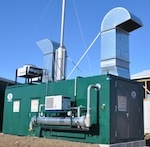
Features
Efficiency
Energy
Biogas gains momentum
May 23, 2013 By Jan M. Buijk
 As a truly renewable resource, biogas can utilize nearly all organic materials, ranging from manure and food waste to energy crops.
As a truly renewable resource, biogas can utilize nearly all organic materials, ranging from manure and food waste to energy crops. In recent years, biogas has been slowly gaining recognition as a renewable resource that can contribute to addressing current and future energy needs across Canada.
One only has to look at the German market to get an appreciation for the potential that biogas has to help address Canada’s energy needs. With more than 2,500 MW of installed capacity, the German market is doing for the biogas industry what Denmark did for the wind industry during the 1980s and 1990s.
As a truly renewable resource, biogas can utilize nearly all organic materials, ranging from manure and food waste to energy crops.
Producing biogas through anaerobic digestion not only creates a fuel source that can be used for cogeneration systems, natural gas conversion, heating fuel and vehicle fuel, but also allows for the recovery of nutrients in the form of fertilizer – another byproduct of anaerobic digestion.
Furthermore, in a world where fossil fuel resources are becoming scarce and more expensive, not to mention causing increasing concerns about climate change, incorporating biogas facilities into the farming industry provides an opportunity to invest in sustainable technologies.
These technologies will help make agriculture and other industries more competitive and create new employment while helping address climate change and energy issues.
THE BIG BREAK?
After a few years during which various incentive programs were implemented across Canada, it is time to take stock of the successes and challenges that have been encountered along the way.
In Ontario, renewable energy programs were first introduced in 2006 with the intent to provide sufficient incentives to help drive the development of renewable energy projects.
Qualified technologies included solar, wind, hydro, landfill gas, biomass and biogas projects in Ontario that connect to the grid either at the distribution level or behind the meter.
Although the program has been touted as the first of its kind in North America, and a lot of farm-based and municipal biogas applications have been received, it quickly became clear that what was good for some projects, fell short for others. Grid connection limitations and various regulatory challenges have prevented or delayed several projects from coming to fruition.
SURVEYING THE LANDSCAPE
In Ontario, dozens of smaller 250 to 500 kW farm-based biogas projects have been developed in response to the Feed-in Tariff Program, introduced by the Ontario Power Authority (OPA) a few years ago.
Good examples of these projects are Clovermead Farms, a dairy farm that installed a 250 kW biogas fuelled combined heat and power (CHP) system that will run on methane produced from cow manure mixed with organic materials from the neighbourhood.
Another example is Ledgecroft Farms, a dairy farm that installed a 500 kW biogas fuelled CHP system.
Similar systems were installed at Bayview Flowers and Vandermeer Greenhouses, where heat recovered from the cogeneration system is utilized for heating the greenhouse.
On the municipal front, there is the Harvest Power site in London, Ont., where a 2.8 MW CHP system has been installed. The system will be run on biogas produced from municipal organic waste.
A similar project is under construction in Elmira, Ont., where Bio-En Power is building a 2.8 MW biogas plant.
Alberta, too, is showing significant biogas activity, where recently commissioned projects include a 2.8 MW system in Lethbridge.
WHAT THE FUTURE HOLDS
It is clear from experiences over the past few years that ongoing program optimization and regulatory changes are necessary to develop a successful Canadian biogas market. As a society we have to determine if we are prepared to cover the cost of capturing the environmental benefits of biogas and other renewable resources or if we choose to utilize lower-cost alternatives that may not deliver the same benefits.
For biogas fuelled CHP systems, the future may well bring solutions such as biogas storage, offering the opportunity to store gas during off-peak hours and in turn utilize this gas for increased power production during peak hours.
Combining biogas fuelled CHP systems with a thermal host, such as a greenhouse, or even cleaning the exhaust gas to a point where the CO2 can be utilized, may be other ways of increasing the value of these types of systems.
In order for these biogas markets to develop, either a proper valuation of the benefits or incentive programs will be required. A well-designed incentive program can be the driving force behind revitalizing agriculture and other industries that are involved with organic materials. Organic materials that used to be considered waste materials to be disposed of can now become a valuable resource.
No one can be sure how this all will come together in the years ahead. What is certain is that there are tremendous opportunities as we face important decisions about how to deal with energy and our environment.
Jan M. Buijk is president and CEO of European Power Systems Ltd.
Print this page